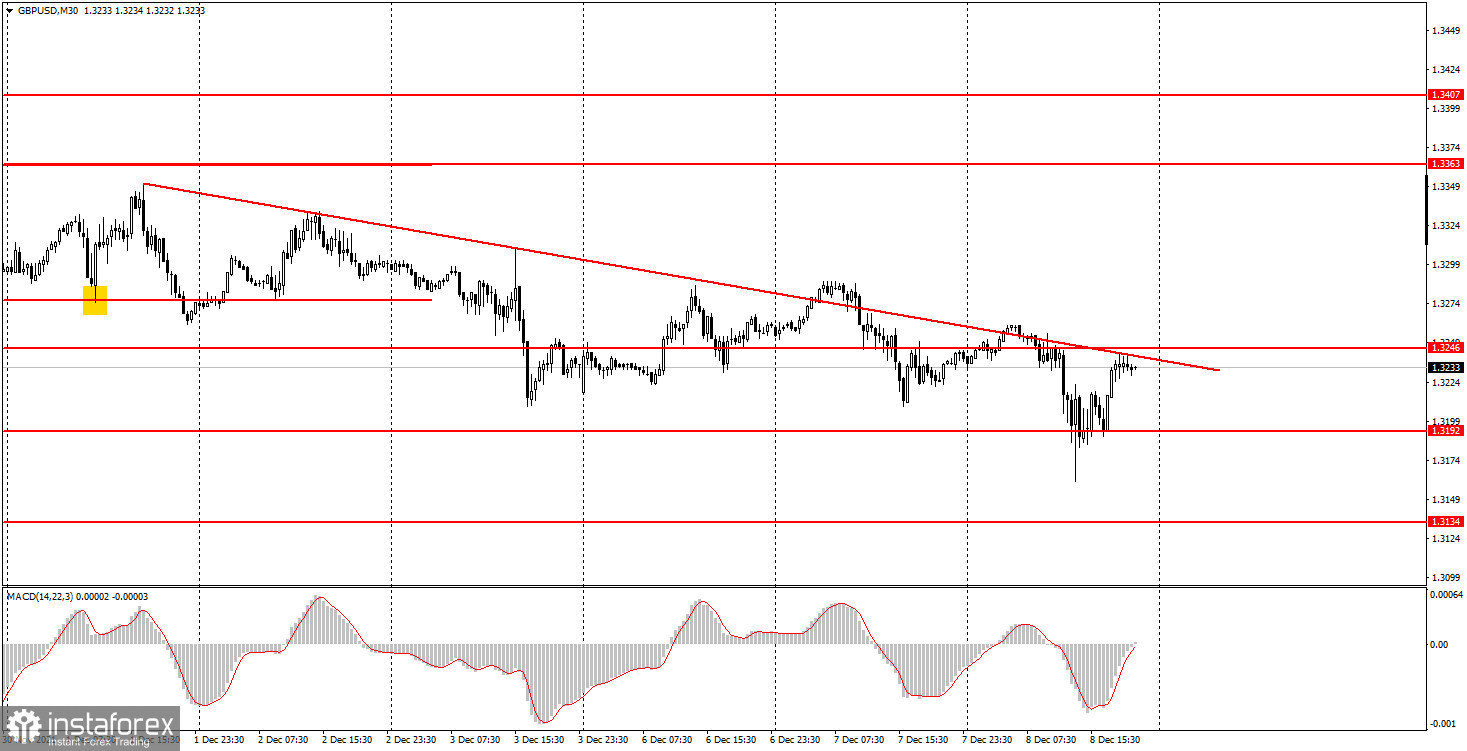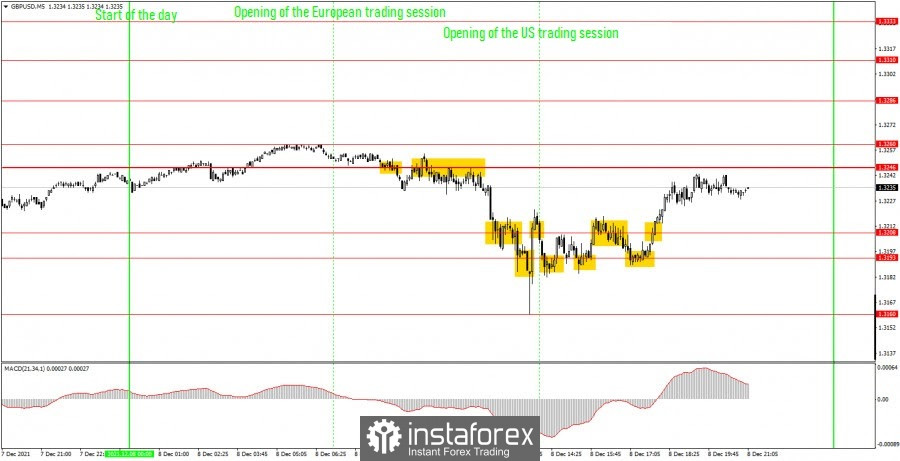Analysis of previous deals:
30M chart of the GBP/USD pair

The GBP/USD pair traded lower on Wednesday and renewed its annual lows. Thus, in general, the pound remains close to them and, therefore, the downward trend continues at this time. However, the trend persists also because traders cannot consolidate the pair above the downtrend line, from which at least six rebounds have already been made. And at this time, the pound quotes are again near this line. If a new bounce follows, then the price may again rush down, as it has done before many times. If traders still manage to settle above the trend line, then, as in the case of the euro currency, the downward trend will be reversed. There were no interesting events and macroeconomic publications in either the UK or the US on Wednesday. Nevertheless, the pair moved quite actively, and in both directions. The volatility of the environment was exactly 100 points.
5M chart of the GBP/USD pair

On the 5-minute timeframe, the movement of the pound/dollar pair was very difficult on Wednesday. This can clearly be seen and without detailed analysis. Nevertheless, let's take a look at these complex movements and understand how one should trade today. The first two sell signals were pretty simple. The price first crossed the 1.3246 level, and then bounced off it. Therefore, beginners could open short positions on these signals. Subsequently, the pair overcame the level of 1.3208, as well as the level of 1.3193 and continued to move downward right up to the level of 1.3160, which was not yet seen today (this is today's low). Thus, a short position should have been closed either by Take Profit 40-50 points, or manually, when the pair settled above the level of 1.3193. One could earn around 30 to 50 points on this trade. Then the pair began to "dance" around the levels 1.3193 and 1.3208. A buy signal (consolidation above the level of 1.3208) should have been ignored, as the pair went up 50 points in 10 minutes. The signal to sell on settling below the level of 1.3208 is also the same, since the price immediately hit the level of 1.3193. The price bounced off the level of 1.3193 twice, then from 1.3208, then again from 1.3193, and only settled above 1.3208 in the middle of the US session. Since the levels 1.3193 and 1.3208 are located very close to each other, all signals about bounces between them should be ignored. The last signal (profitable, by the way) should also be missed, since it was formed too late.
How to trade on Thursday:
At this time on the 30-minute timeframe, the downward trend persists, although at this time it is already completely ambiguous, since yesterday the downtrend line was broken, and the price bounced off it six times. Thus, today traders can try to overcome it again and change the trend to an upward one. The important levels on the 5 minute timeframe are 1.3160, 1.3193, 1.3208, 1.3246, 1.3260, 1.3286 and 1.3310. We recommend trading on them on Thursday. The price can bounce off them or overcome them. As before, we set Take Profit at a distance of 40-50 points. At the 5M TF, you can use all the nearest levels as targets, but then you need to take profit, taking into account the strength of the movement. When passing 20 points in the right direction, we recommend setting Stop Loss to breakeven. There will be no major events or publications in the UK and America on December 9th. Therefore, the movements may again not be the most pleasant.
Basic rules of the trading system:
1) The signal strength is calculated by the time it took to form the signal (bounce or overcome the level). The less time it took, the stronger the signal.
2) If two or more deals were opened near a certain level based on false signals (which did not trigger Take Profit or the nearest target level), then all subsequent signals from this level should be ignored.
3) In a flat, any pair can form a lot of false signals or not form them at all. But in any case, at the first signs of a flat, it is better to stop trading.
4) Trade deals are opened in the time period between the beginning of the European session and until the middle of the US one, when all deals must be closed manually.
5) On the 30-minute TF, using signals from the MACD indicator, you can trade only if there is good volatility and a trend, which is confirmed by a trend line or a trend channel.
6) If two levels are located too close to each other (from 5 to 15 points), then they should be considered as an area of support or resistance.
On the chart:
Support and Resistance Levels are the Levels that serve as targets when buying or selling the pair. You can place Take Profit near these levels.
Red lines are the channels or trend lines that display the current trend and show in which direction it is better to trade now.
The MACD indicator consists of a histogram and a signal line. When they cross, this is a signal to enter the market. It is recommended to use this indicator in combination with trend lines (channels and trend lines).
Important speeches and reports (always contained in the news calendar) can greatly influence the movement of a currency pair. Therefore, during their exit, it is recommended to trade as carefully as possible or exit the market in order to avoid a sharp price reversal against the previous movement.
Beginners on Forex should remember that not every single trade has to be profitable. The development of a clear strategy and money management are the key to success in trading over a long period of time.
 English
English 
 Русский
Русский Bahasa Indonesia
Bahasa Indonesia Bahasa Malay
Bahasa Malay ไทย
ไทย Español
Español Deutsch
Deutsch Български
Български Français
Français Tiếng Việt
Tiếng Việt 中文
中文 বাংলা
বাংলা हिन्दी
हिन्दी Čeština
Čeština Українська
Українська Română
Română

